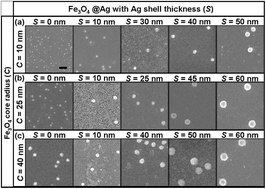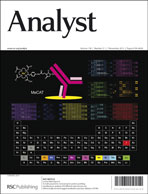Optimization of Fe3O4@Ag nanoshells in magnetic field-enriched surface-enhanced resonance Raman scattering for malaria diagnosis
Abstract
The great potential of magnetic field enriched surface enhanced resonance Raman spectroscopy (SERRS) for early malaria diagnosis has been demonstrated previously. This technique is able to detect β-hematin, which is equivalent to a malaria biomarker (hemozoin) in Raman features, at a concentration of 5 nM. In this study, we present the optimization of nanoparticles used in the magnetic field enriched SERRS by tuning the core size and shell thickness of nanoparticles with an iron oxide core and a silver shell (Fe3O4@Ag). The discrete dipole approximation (DDA) model was introduced to investigate the localized electromagnetic field distributions and extinction efficiencies of the aggregate of Fe3O4@Ag and β-hematin, in correlation with their magnetic field enriched SERRS performance. We find that the optimal core–shell size of Fe3O4@Ag leading to the effective aggregation of Fe3O4@Ag and β-hematin under an external magnetic field with superior extinction efficiencies is the key to realize highly augmented Raman signals in this strategy. Furthermore, it is noted that the optimized result differs from the case without the external magnetic field to that with the external magnetic field. Therefore, this work demonstrates experimentally and theoretically the potential of tuning the core–shell Fe3O4@Ag for achieving the efficient magnetic field-enriched SERRS detection of β-hematin for early malaria diagnosis.


 Please wait while we load your content...
Please wait while we load your content...